1988 PONTIAC FIERO oil
[x] Cancel search: oilPage 789 of 1825
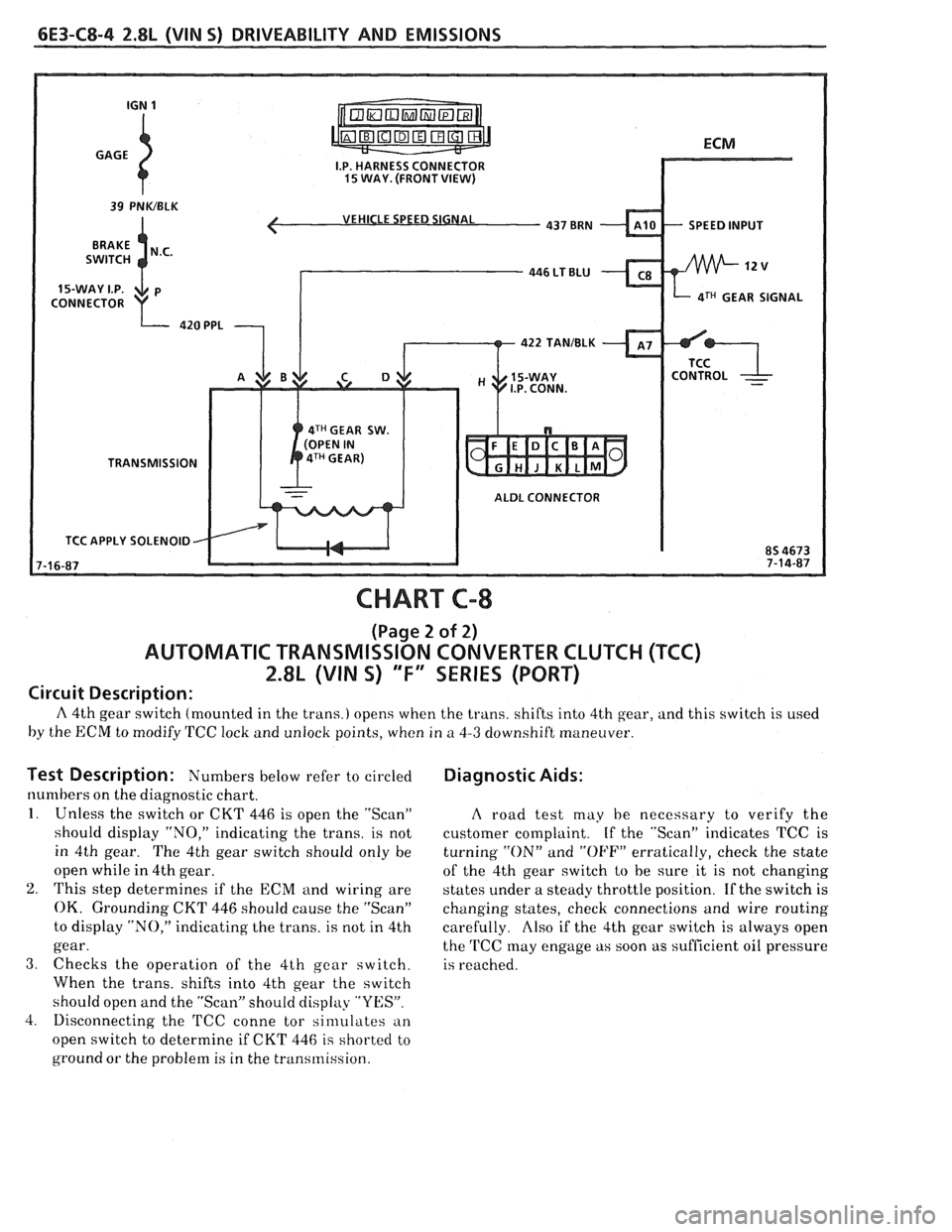
6E3-C8-4 2.8L (VIN 5) DRIVEABILITY AND EMISSIONS
VEHICLE SPEED SIGNAL
4TH GEAR SIGNAL
422 TANIBLK
4TH GEAR SW.
TRANSMISSION
ALDL CONNECTOR
TCC APPLY SOLENOID
CHART C-8
(Page 2 of 2)
AUTOMATIC TRANSMISSION CONVERTER CLUTCH (TCC)
2.8L (VIN S) "F" SERIES (PORT)
Circuit Description:
A 4th gear switch (mounted in the trans.) opens when the trans. shifts into 4th gear, and this switch is used
by the ECM to modify TCC lock and unlock points, when in
a 4-3 downshift maneuver.
Test Description: Numbers I~elow refer to circled
numbers on the diagnostic chart.
1. Unless the switch or CKT 446 is open the "Scan"
should display "NO," indicating the trans. is not
in 4th gear. The 4th gear switch should only be
open while in 4th gear.
2. This step determines if the ECM and wiring are
OK. Grounding CKT 446 should cause the "Scan"
to display "NO," indicating the trans. is not in 4th
gear.
3. Checks the operation of the 4th gear switch.
When the trans. shifts into 4th gear the switch
should open and the "Scan" should display "YES".
4. Disconnecting the
'FCC conne tor sinlulates an
open switch to determine if CKT 446
is shorted to
ground or the problem is in the transmission.
Diagnostic Aids:
A road test may he necessary to verify the
customer complaint. If the "Scan" indicates TCC is
turning
"ON" and "OFF" erratically, check the state
of the 4th gear switch
to be sure it is not changing
states under a steady throttle position. If the switch is
changing states, check connections and wire routing
carefully.
Also if the 4th gear switch is always open
the
'FCC may engage as soon as sufficient oil pressure
is reached.
Page 793 of 1825
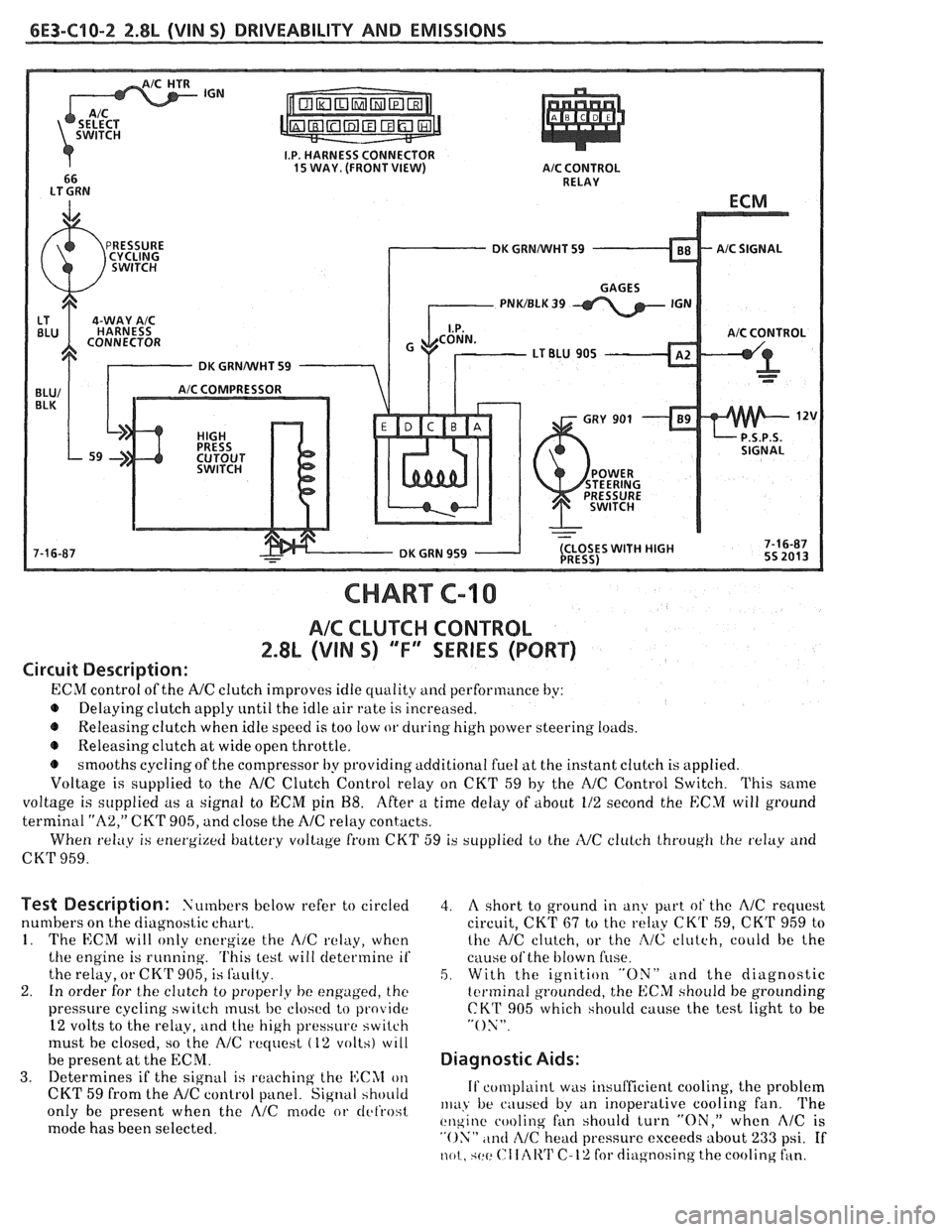
6E3-C10-2 2.8L (VIN S) DRIVEABILITY AND EMISSIONS
A/C CONTROL
DK GRNNVHT 59
CHART C-10
AIC CLUTCH CONTROL
2.8L (VIN S) "F" WRIES (PORT)
Circuit Description:
ECM control of the A/C clutch improves idle quality and performance by:
Delaying clutch apply
until the idle air rate is increased.
e Releasing clutch when idle speed is too low or during high power steering loilds.
e Releasing clutch a1 wide open throttle.
smooths cyclingof the compressor by providing additional fuel at the instant clutch
is applied.
Voltage is supplied to the
NC Clutch Control relay on CKT 59 by the NC Control Switch. This saine
voltage is supplied as a signal to ECM pit1 88. After a time delay of about 112 second the ECM twill ground
terminal
"A2," CKT 905, and close the A/C relay contacts.
When
relay is energi~etf battery vollage from CKT 59 is supplied to the IVC clulch lhroug11 Ihe txlay arid
CKT 959.
Test Description: Numbers below refer to circled
numbers on the diagnostic chart.
1. The ECM will only energize the A/C relay, when
the engine is running.
'I'his lest will determine if
the relay, or CK'F 905, is Sauity.
2. In order for the clutch to proper1.y be engaged, the
pressure cycling switch must bc closc!cl to provide
12 volts to the relay,
ilnd the high pressure switch
must be closed, so the
AlC rtquest (12 volts) wlll
be present at the ECNI.
3. Determines if the signal is ~.eachitlg the I4:CAI on
CKT 59 from the A/C control panel. Signal hhoitld
only be present when the AlC mode or tlcl'rost
mode has been selected.
4. A short to ground in any part ot' the A/C request
circuit, CKT
67 to the relay CKrI' 59, CKT 959 to
the NC clutch, or the
:2/C clutch, coulcl be the
cause
ofthe blown fiise.
5. With the ignition "ON" and the diagnostic
tcrminal grounded, the ECM should be grounding
CKT 905 which should cause the test light to be
"ON".
Diagnostic Aids:
If complaint was insufficient cooling, the problem
111~1,~ be ciiuscd by an inoperalive cooling fan. 'I'he
t!11gine cooling fan should turn "ON," when AlC is
"ON" ,tntl cZ/C head pressure exceeds about 233 psi. If
not. qctt: ("I Iclli'I' C-12 for diagnosing the cooling fan.
Page 797 of 1825
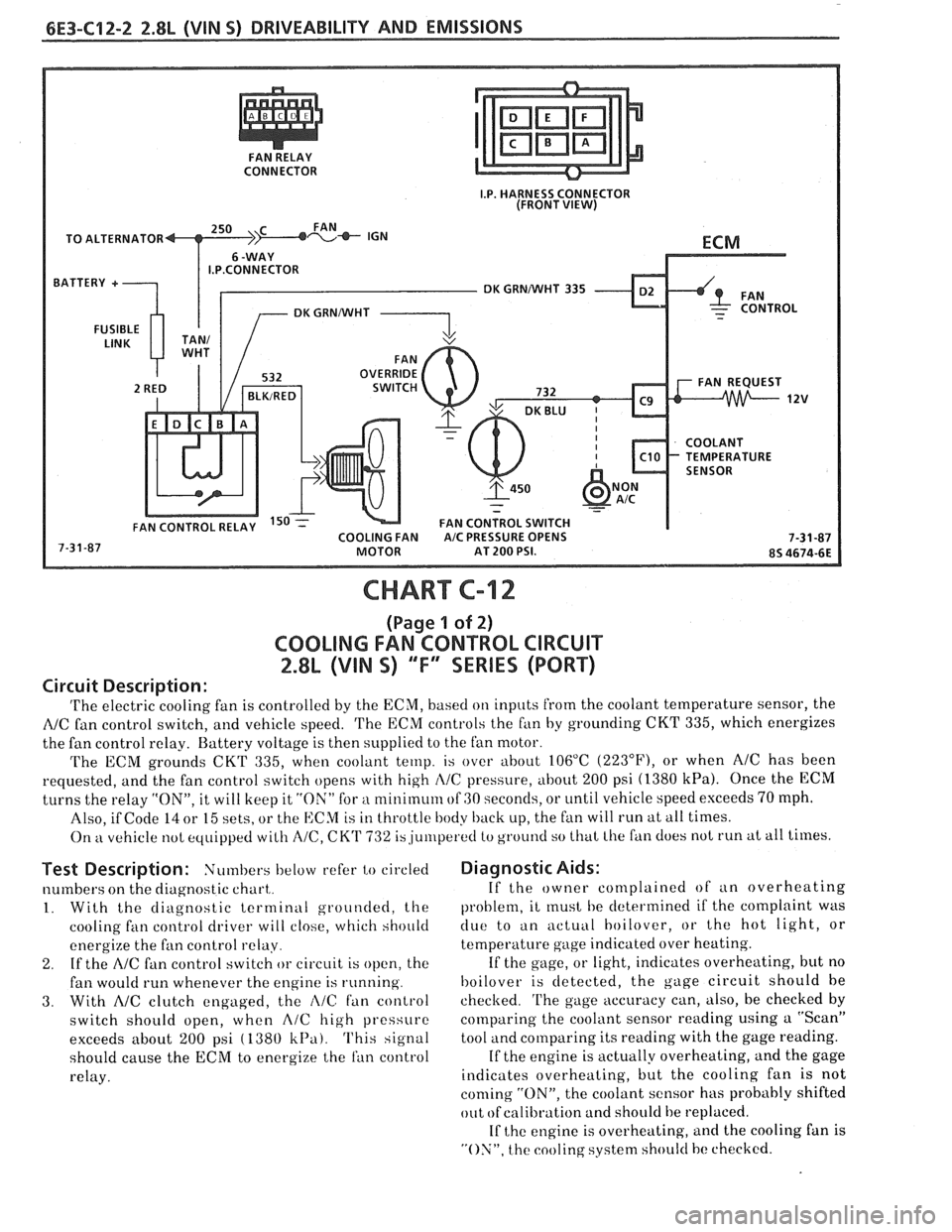
CONNECTOR
TO ALTERNATOR
I.P.CONNECTOR
DK GRNNVHT 335
CHART C-12
(Page 1 of 2)
COOLING FAN CONTROL CIRCUIT
2.8L (VIN S) "F" SERIES (PORT)
Circuit Description:
'I'he electric cooling fan is controlled by the ECM, based on inputs from the coolant temperature sensor, the
NC fan control switch, and vehicle speed. 'I'he ECM controls the f~in by grounding CKT 335, which energizes
the fan control relay. Battery voltage is then supplied to the fan motor.
The ECM grounds
CKT 335, when coolant temp. is over about 106°C (223"F), or when AIC has been
requested, and the fan control switch opens with high
I\/C pressure, about 200 psi (1380 kPa). Once the ECM
turns the relay "ON", it will keep it "ON" for a nlinirnum of GO seconds, or until vehicle speed exceeds 70 mph.
Also, if Code
14 or 15 sets, or the ECM is in throttle body back up, the fan will run at all times.
On
kt vehicle not equipped with A/C, CK'I' 732 is,ju~rlperetl to ground so that Lhe fan does not run at all times.
Test Description: Numbers below refer to circled
numbers on the diagnostic chart,.
1. With the diagnostic terminal grounded, the
cooling
fan control driver will close, which should
energize the fan control
relay.
2. If the A/C fan control switch or circuit is open, the
fan would run whenever the engine is running.
3. With AIC clutch engaged, the i\lC fan control
switch should open, when
A/C high pressure
exceeds about
200 psi ( 1380 k13a). This signal
should cause the
ECM to energize the ran control
relay.
Diagnostic Aids:
If the owner complained of an overheating
problem, it
rnust he determined if the complaint was
clue to an actuill hoilover, or the hot light, or
temperature gage indicated over heating.
If the gage, or light, indicates overheating, but no
hoilover is detected, the gage circuit should he
checked.
'I'he gage accuracy can, also, be checked by
comparing the coolant sensor reading using a "Scan"
tool and comparing its reading with the gage reading.
If the engine is actually overheating, and the gage
indicates overheating, but the cooling fan is not
coming "ON", the coolant sensor has probably shifted
out
ofcalibration and should be replaced.
If
the engine is overheating, and the cooling fan is
"ON", the cooling system should hc checked.
Page 802 of 1825

DRIVEABILITY AND EMISSIONS 2.8L (VIN S) 6E3-C13-1
SECTION C13
POSITIVE CRANKCASE VENTILATION (PC\/)
.... GENERAL DESCRIPTION ................ C13-1 FUNCTIONAL CHECK OF PCV VALVE C13-1
RESULTS OF INCORRECT OPERATION .... C13-1 ON-CAR SERVICE ..................... C13-2
DIAGNOSIS
......................... C13-1 PARTS INFORMATION ................. C13-2
GENERAL DESCRIPTION 4. Turn "OFF" the engine and remove PCV valve.
Shake valve and listen for the rattle of check
A "closed" crankcase ventilation (PCV) system is needle inside
the valve. If valve does not rattle,
used to provide more complete scavenging of replace
v4 ~1 1 ve.
crankcase vapors. Fresh air from the air cleaner is With this
system, any blow-by in excess of the
slipplied to the crankcase, mixed with blow-by gases system capacity (from a badly-worn engine, sustained
and then passed through a positive crankcase heavy load, etc.) is exhausted into the air cleaner and
ventilation
(PCV) valve into the intake manifold isdrawn into theengine.
(Figure C13-1).
The primary control is through the PCV valve
(Figure
(213-2) which meters the flow at a rate
depending on manifold vacuum.
To maintain idle quality, the PCV valve restricts
the flow when intake manifold vacuum is high. If
abnormal operating conditions arise, the system is
designed to allow excessive amounts
of I,low-by gases
to back flow through the crankcase vent tube into the
engine air inlet to be consumed by normal combustion.
RESULTS OF INCORRECT OPERATION
A plugged valve or hose may cause:
@ Rough idle.
@ Stalling or slow idle speed.
@ Oil leaks.
@ Sludge in engine.
A leaking valve or hose would cause:
@ Rough idle.
@ Stalling.
@ Iiigh idle speed.
DIAGNOSIS
FUNCTIONAL CHECK OF PCV VALVE
If an engine is idling rough, check for a clogged
PCV valve or plugged hose. Replace as required. Use
the following procedure:
1. Remove PCV valve from rocker arm cover.
2. Run the engine at idle.
3. Place your thumb over end of vi~lcce to check for
vacuum. If there is
no vacuum at valve, chcck for
plugged hoses or
lrlanifold port, or 1'CV valve.
Replace plugged or dcterioratcd hoses.
a CLEAN AIR
VOLATILE OIL FUMES
---e- MIXTURE OF AIR AND FUMES
PCV VALVE
1 TO THROTTLE BODY
CRANKCASE VENT HOSE
1 PCV VALVE HOSE
150 INTAKE MANIFOLD
Figure C13-1 PCV Flow
Page 803 of 1825
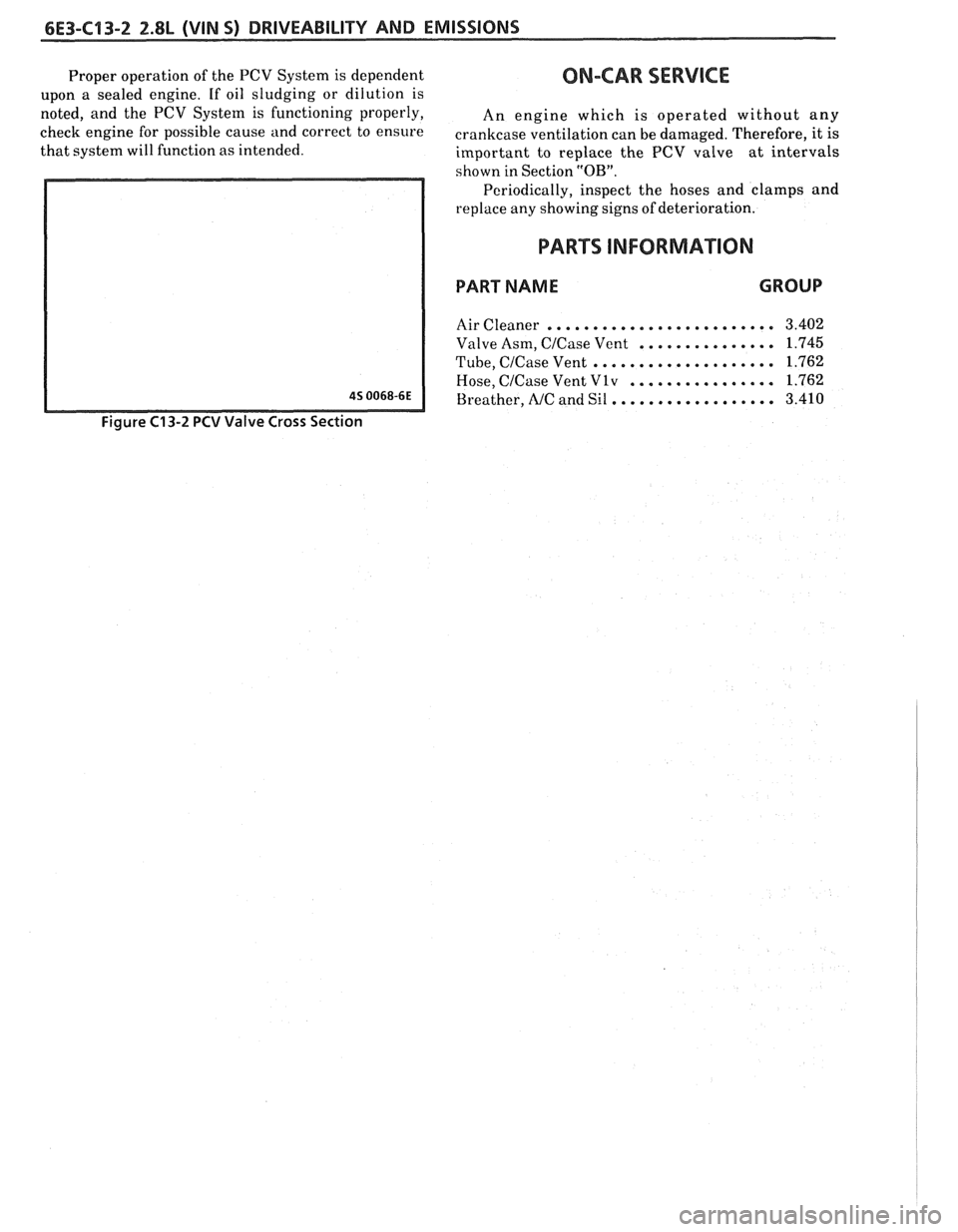
6E3-C13-2 2.8L (VIN 5) DRIVEABILITY AND EMISSIONS
Proper operation of the PCV System is dependent ON-CAR SERVICE
upon a sealed engine. If oil sludging or dilution is
noted, and the PCV System is functioning properly,
An engine which is operated without any
check engine for possible cause and correct
to ensure crankcase ventilation can be damaged. Therefore, it is
that system will function as intended.
important to replace the PCV valve at
intervals
shown in Section
"OB".
Periodically, inspect the hoses and clamps and
replace any showing signs of deterioration.
I I PARTS INFORMATION
PART NAME GROUP
Figure C13-2 PCV Valve Cross Section
......................... Air Cleaner 3.402
............... Valve Asm, C/Case Vent 1.745
.................... Tube, C/Case Vent 1.762
................ Hose, C/Case Vent V 1 v 1.762
.................. Breather, NC and Sil 3.410
Page 805 of 1825
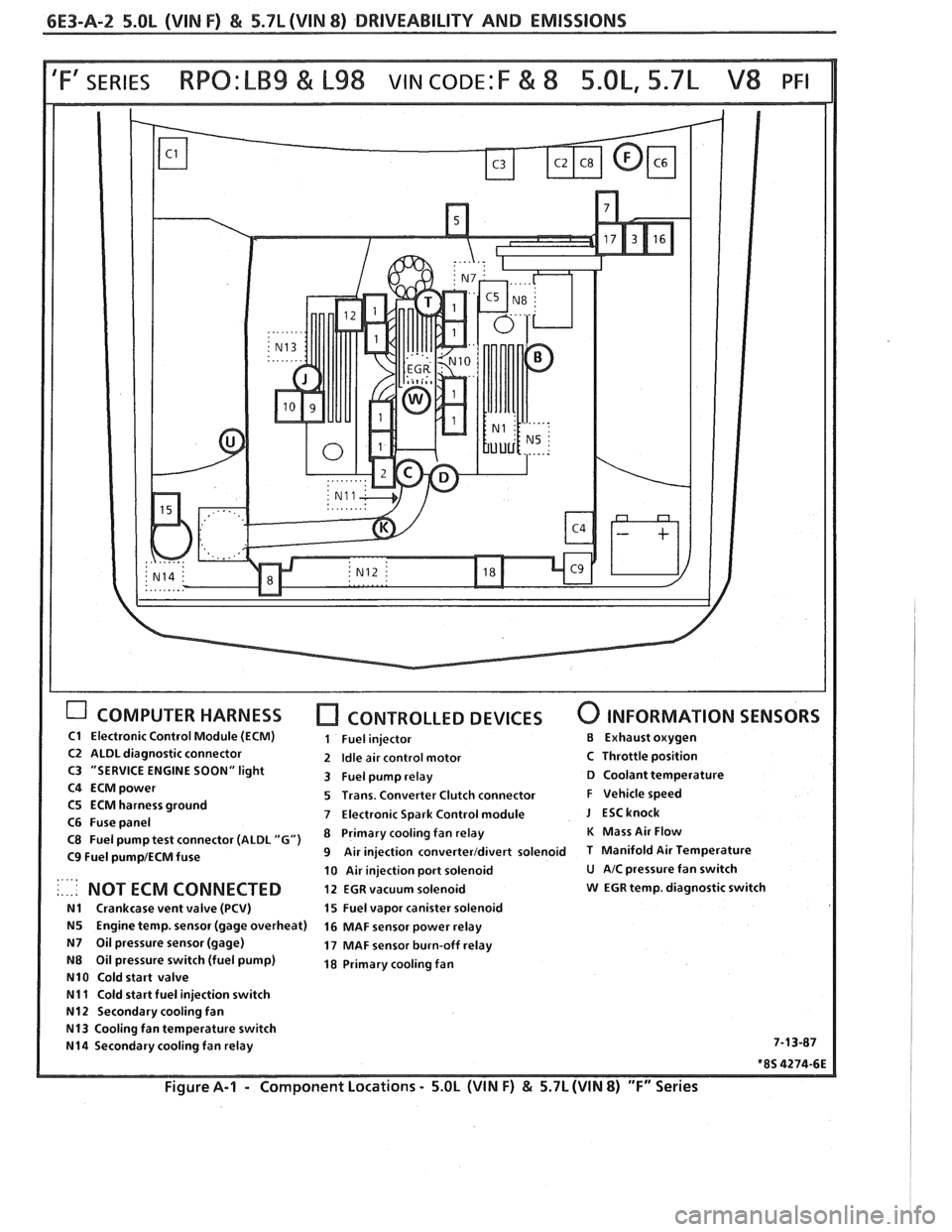
6E3-A-2 5.OL (VIN F) & 5.7L(VIN 8) DRIVEABILITY AND EMISSIONS
COMPUTER HARNESS [7 CONTROLLED DEVICES 0 INFORMATION SENSORS
C1 Electronic Control Module (ECM) 1 Fuel injector €3 Exhaust oxygen
C2 ALDL diagnostic connector 2 Idle air control motor C Throttle position
C3 "SERVICE ENGINE SOON" light
3 Fuel pump relay D Coolant temperature
C4
ECMpower 5 Trans. Converter Clutch connector F Vehicle speed
C5 ECM harness ground
7 Electronic Spark Control module J ESCknock C6 Fuse panel
C8 Fuel pump test connector (ALDL "G") Primary fan relay K Mass Air Flow
C9 Fuel pump1ECM fuse 9 Air injection converterldivert solenoid T Manifold Air Temperature
10 Air injection port solenoid
U AIC pressure fan switch . ., .. .. NOT ECM CONNECTED 12 EGR vacuum solenoid w EGR temp. diagnostic switch
N1 Crankcase vent valve (PCV) 15 Fuel vapor canister solenoid
N5 Engine temp. sensor (gage overheat)
16 MAF sensor power relay
N7 Oil pressure sensor (gage) 17 MAF sensor burn-off relay
N8 Oil pressure switch (fuel pump) 18 Primary cooling fan
N10 Cold start valve
N11 Cold start fuel injection switch
N12 Secondary cooling fan
N13 Cooling fan temperature switch
N14 Secondary cooling fan relay 7-13-87
*8S 4274-6E
Figure A-I - Component
Locations - 5.OL (WIN F) & 5.7L (WIN 8) "F" Series
Page 807 of 1825
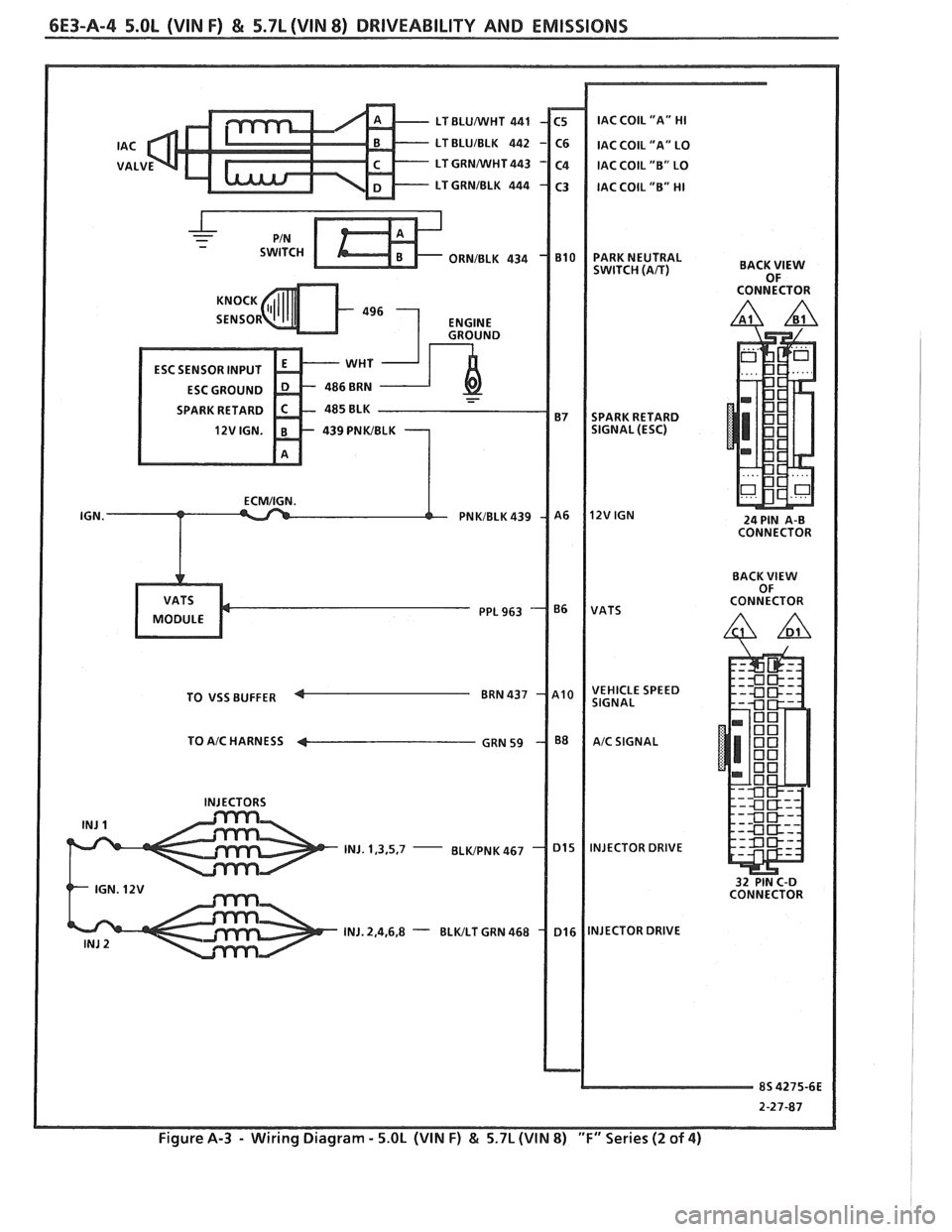
6E3-A-4 5.OL (VIN F) & 5.7L (VIN 8) DRIVEABILITY AND EMISSIONS
I
LT BLUNVHT 441 IAC COIL "A" HI
SPARK
RETARD
TO
VSS BUFFER
TO
A/C HARNESS 4
INJ. 1,3,5,7 -
BACK VlEW OF
CONNECTOR
24 PIN A-B
CONNECTOR
BACK
VlEW OF
CONNECTOR
32 PIN C-D
CONNECTOR
2-27-87
Figure A-3 - Wiring Diagram - 5.OL (VIN F) & 5.7L (VIN 8) "F" Series (2 of 4)
Page 813 of 1825

TO MAF SENSOR
POWER & BURN-OFF
RELAY, OIL PRESS. SW.
.....-
439 PNKIBLK
419 BRNNVHT
SERIAL DATA
451 WHTIBLK
450
BLWHT
ALDL CONNECTOR
CHART A - 1
NO "'SERVICE ENGINE SOON" LIGHT
5.OL (VIN F) & 5.7L (VIN 8) "F'XSEBIE'S (PORT)
Circuit Description:
There should always be a steady "Service Engine Soon" light when the ignition is "ON" and engine stoppccl.
Ignition voltage is supplied directly to the light bulb. The electronic control module (ECM) will control the light
and turn it
"ON" by providing a ground path through CKT 419 to the ECM.
Test Description: Numbers below refer to circled
numbers on the diagnostic chart.
1. If the fuse in holder is blown, refer to facing page
of Code
54 for complete circuit.
2. Using a test light connected to 12 volts probe each
of the system ground circuits to be sure a good
ground is present. Refer to the ECM terminal end
view in front of this section for ECM pin locations
of ground circuits.
Diagnostic Aids:
Engine runs OK, check:
r Faulty light bulb.
@ CKrI' 419 open.
@ Gage fuse blown. This
will result in no oil or
generator lights, seat belt reminder, etc.
Engine cranks but will not run, check:
r Continuous battery - fuse or fusible link open.
@ ECM ignition fuse open.
r Battery CKT 340 to ECM open.
@ Ignition CKT 439 to ECM open.
@ Poor connection to ECM.